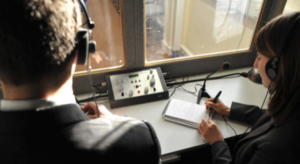Why interpreters work in pairs
There are several studies that show that interpreters, who work with a high level of concentration, cannot work uniformly for long. They may start well, but after a while they will feel a bit tired and the quality of the delivery starts to drop. Simultaneous interpretation requires that three efforts occur simultaneously: listening in one language, processing the message, and then delivering it back in another language. These three steps happen at the same time, all the time. There are those who can interpret very well for 15 minutes, then they begin to have difficulty understanding the speaker, that is, one of the efforts is suffering more than the other. Others get up to 60 minutes. But the speaker’s message will not be interpreted correctly for long by an interpreter alone. So, read along and find out why interpreters work in pairs….
And doesn’t the speaker doesn’t talk alone for a long time?
The cognitive effort of speaking is completely different from the concentration effort required to do simultaneous translation.

Why do interpreters work in pairs ?
What are the rules for interpreting?
A pair of interpreters will work for six hours together –after that it goes into additional hours that are billed separately. When the work is over eight hours, we suggest working with a trio of interpreters, so that the result is good for the client. Working for an hour, three or six hours will also require the dedication of a whole day on the date of the event and possibly many other hours in the run-up, as interpreters prepare themselves by making glossaries, watching videos on YouTube to learn about the speakers accents, and they also do research on the topic, in order to communicate the message correctly on the day.
In remote or face-to-face work, interpreters work in partnership inside a virtual or normal interpreting booth. One helps the other.
If you have any questions about this topic, write to vivian@interpretesprofissionais.com.br – we will be happy to answer and clarify.
Simultaneous translation Brazil






Leave A Comment